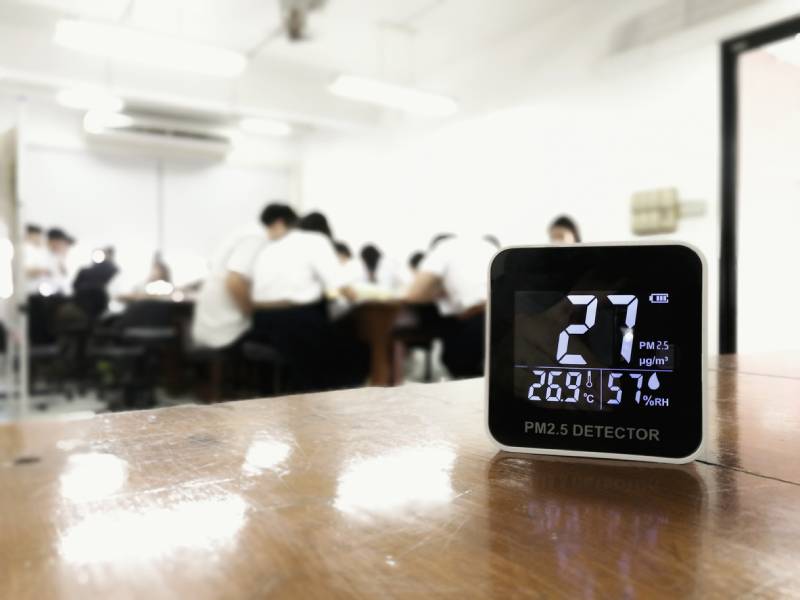When you spend eight or more hours working in a well-sealed office building, the quality of the air you breathe contributes significantly towards your long-term health. Read on to learn how you can identify whether you have poor indoor air quality at work and how to address IAQ issues in the workplace.
Educate Yourself on Sick Building Syndrome
If you often feel sick, with flu-like symptoms including sore throats, headaches or itchy eyes that only seem to get worse over time, you might be a victim of “sick building syndrome.”
Pollutants such as formaldehyde, cigarette smoke, volatile organic compounds (VOCs) and other toxins can contribute to SBS, and if left unchecked, can cause serious health problems such as asthma, various allergies and even cancer. Fortunately, you can improve indoor air quality at work by reducing toxins, thereby enjoying a more healthful work environment.
Understand the Common Causes of Poor IAQ
The most common causes of poor indoor air quality are:
- Having poor ventilation that doesn’t allow fresh outdoor air to be brought in, or, when fresh outdoor air is brought in, it is often contaminated in the process
- Poor upkeep and lack of maintenance of ventilation, air conditioning and heating systems
- Allowing leaks, flooding, or high humidity to continue unchecked and cause dampness and moisture damage
- Toxins contributed by occupant activities such as extensive remodeling or construction
- Contaminated indoor and outdoor air
Every work environment has unique contributors to their indoor air quality. Be aware of any possible health impacts of potentially hazardous chemicals and products used in your workplace. If you are concerned with your workplace air quality, communicate with your organization in order to achieve a holistic solution.
Take Actionable Steps for Improving IAQ at Work
Actionable steps for improving indoor air quality at work that anyone can benefit from include:
- Encourage natural ventilation by opening windows or any doors that might open to the outside. Allowing air to circulate through your work space can help in reducing dust particles. To ensure energy efficiency, be sure the air conditioner is turned off.
- Many indoor toxins come from the products we use, including our cleaning products. Choosing mild, non-toxic or natural and biodegradable cleaning products can help with indoor air quality. If you work in a large building that hires a dedicated cleaning staff, contact building management to discuss safe commercial cleaning products.
- In addition to using non-toxic cleaning products, choose non-toxic pest control methods.
- Add houseplants throughout your building. Scientists at the National Aeronautics and Space Administration and the Associated Landscape Contractors of America (ALCA) have recently released published studies touting the amazing abilities of houseplants on indoor air quality. Houseplants not only absorb common indoor pollutants like benzene, trichloroethylene and formaldehyde, but can also assist in the balancing of indoor humidity.
- Avoid the use of air fresheners whenever possible. Most manufactured air fresheners contain the four basic ingredients of formaldehyde: aerosol propellants, petroleum distillates and p-dichlorobenzene. All of these contribute to poor indoor air quality and can cause a number of potentially hazardous health effects including — but not limited to — nausea, respiratory problems, chemical pneumonia, skin lesions and liver damage. Alternatives to these sickness-inducing products include the use of essential oils, naturally-made potpourri, the simmering of spices like cloves, cinnamon and nutmeg, and more.
- When remodeling must be done in your workplace, insist that a low to no-VOC paint is used.
- Ensure that any high moisture areas are well ventilated and frequently cleaned in order to prevent the growth of mold and mildew.
- If you are unable to open windows, consider purchasing a HEPA (high efficiency particulate air) filter. HEPA air filters are available in mobile units and whole-building systems; they are often considered a frontline defense against many airborne diseases and pollutants. HEPA filtration units are generally very quiet and come in models for most any budget, making them great office additions. HEPA air purifier products that combine electrostatic and mechanical filtration processes are capable of trapping as much as 99.97 percent of microscopic particles, odors and gas pollutants.
Comprehensive Indoor Air Quality Solutions for Work & Home
The quality of a person’s working environment greatly affects their health, comfort, and ability to work. Good indoor air quality includes having a comfortable temperature and humidity, a decent supply of fresh outdoor air, and control of pollutants. For more tips for improving indoor air quality at work, or to learn about other HVAC solutions and services, contact your New Orleans area professionals at Bryans United Air Conditioning.
Originally published in August 2013, revised in November 2020
Image provided by iStock


